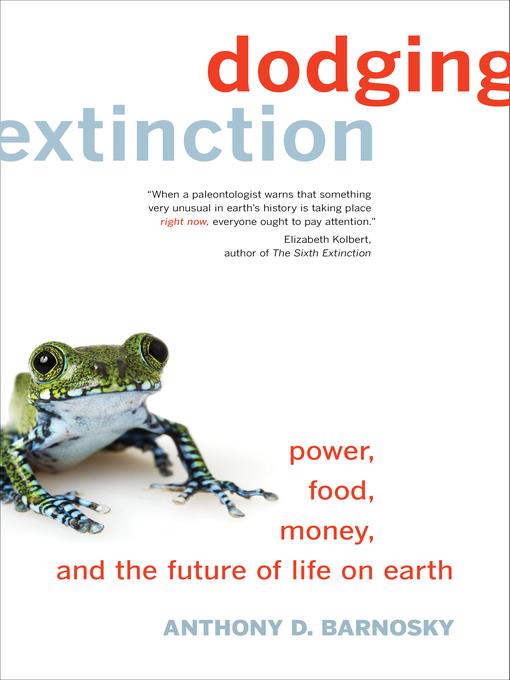
Dodging Extinction
Power, Food, Money, and the Future of Life on Earth
کتاب های مرتبط
- اطلاعات
- نقد و بررسی
- دیدگاه کاربران
نقد و بررسی

August 18, 2014
In powerful and passionate prose, Barnosky, professor of biology at the University of California, Berkeley, outlines the environmental crisis humans have created and provides reasons to be optimistic that the world’s sixth mass extinction may not be inevitable. Barnosky focuses on the impacts posed by three major human endeavors: making money; creating energy; and feeding the world. In each case, he successfully integrates biology with public policy and economics, recognizing that solutions will have to come from an interdisciplinary approach. Barnosky’s plentiful evidence for his arguments includes many of his own research lab’s estimates of the rate of species extinction. Although“continuing the species-loss trajectory we are now on will all but assure that we bring on the Sixth Mass Extinction in as little as three centuries” and ecological change “now outpaces, and is observable within, a single human lifetime,” solutions are possible. Barnosky bolsters his argument that “there is no reason that carbon-neutral energy production cannot be scaled up dramatically and quickly,” with the specifics to make his claim believable. Time may be short, but this is a message of hope for readers looking for a better future.

August 15, 2014
A paleontologist warns that our planet may be on the verge of a "mass extinction-when more than 75% of the Earth's known species die off in a geological eye blink." This has occurred "five times in the 550 million years that diverse life has occupied Earth."Barnosky (Integrative Biology/Univ. of California; Heatstroke: Nature in an Age of Global Warming, 2008, etc.) offers an assessment of how we can avert such a disaster while providing a decent standard of living for the world's human population and protecting our fellow species. In support of his prediction of a looming catastrophic event, he notes that today, increasing numbers of species are threatened with extinction as their death rates exceed their birth rates. As the author writes, the sum of "vulnerable, endangered and critically endangered species is a whopping 20,614 species." In some instances, this is directly attributable to climate, but it is also due to the encroachment of humans. Barnosky examines recent evidence about the effects of global warming that supports his claim, including the calamitous results from Hurricane Sandy in 2012, when Arctic air moving south intensified the effects of the storm. The author emphasizes the need for a rapid shift to alternative energies. In his opinion, such a transformation can, and should, take place without jeopardizing "the high quality of life that billions of people now enjoy and billions more aspire to." Barnosky's goal is to significantly reduce global carbon emissions by 2050 using a variety of methods: carbon capture, protecting forests, soil conservation, a shift to wind and solar power, biofuels made from special grasses, electric cars and even advanced-design nuclear power generators. The author emphasizes that for such a program to succeed within 35 years, incentives must be offered entrepreneurs to encourage them to invest in green technologies. A pragmatic approach to finding workable solutions to a looming crisis.
COPYRIGHT(2014) Kirkus Reviews, ALL RIGHTS RESERVED.

Starred review from September 1, 2014
According to the best scientific evidence, some 20,000 species of plants and animals are headed for extinction in the next few centuries. Paleontologist Barnosky (integrative biology, Univ. of California, Berkeley) describes how this crisis is a result of human activity--burning fossil fuels, converting wildlife habitats into farm and pasture land, and overhunting. The author convincingly argues that to avoid a sixth mass extinction (Earth has undergone five others), we must change the way we generate energy, ramp up food production, and shift our focus to the long-term benefits of intact ecosystems (such as standing rain forests). While Barnosky is an optimist about the human potential to implement more ecologically sound alternatives, he's also a realist who recognizes that we must overcome a great deal of political, social, and cultural inertia toward changing our ways. VERDICT A superior synthesis of recent research from many scientific disciplines, this eloquent book could serve as a model for how scientists should write for nonspecialists about the critical environmental challenges of our time. An excellent companion to Elizabeth Kolbert's The Sixth Extinction.--Cynthia Lee Knight, formerly with Hunterdon Cty. Lib., Flemington, NJ
Copyright 2014 Library Journal, LLC Used with permission.

























دیدگاه کاربران